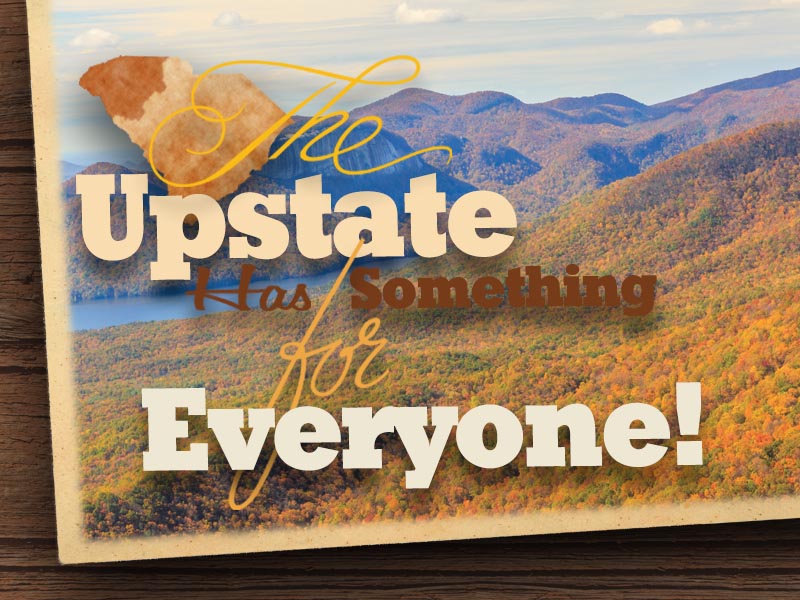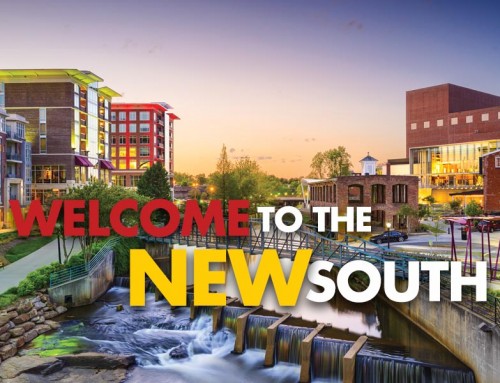There’s something for everyone in the Upstate Region of South Carolina! The Upstate begins at the Georgia border and follows the foothills of the Blue Ridge Mountains all the way east to the Catawba River basin.
The general definition of the Upstate includes ten counties along the I-85 corridor, the fastest growing region in South Carolina. Greenville is the largest city in the Upstate, followed by Spartanburg and Anderson. This diverse region offers a wealth of excitement for shoppers, golfers and outdoor enthusiasts.
In the Upstate, you can go white water rafting or canoeing in the numerous lakes and rivers, hike or bike the scenic mountain trails and winding country roads, or go horseback riding where the Cherokee once roamed. You can become part of a living history demonstration, tour the grounds of an Old South plantation or explore a working farm. You’ll enjoy visiting the many small towns or vibrant cities for fantastic shopping at the outlet stores, malls and boutiques. Don’t forget to bring your appetite because the food is delicious and abundant!
For starters, take a break from the Interstate and discover scenic South Carolina Highway 11 as it follows the low hills of the Piedmont and Blue Ridge from the North Carolina border to Georgia. You’ll love the magnificent views and the many attractions along the way.
For example, within a 90-minute drive you can experience the 19th, 20th and 21st centuries through four bridges and a restored grist mill. The oldest bridge in South Carolina, Poinsett’s Bridge, was built in 1820 and named after Joel Poinsett, who introduced the beautiful Poinsettia plant to the United States. Campbell’s Covered Bridge was built in 1909 and is the oldest covered bridge in the State. Ballenger’s Mill & Covered Bridge provides a glimpse of life in the 1800’s, and Klickey-Klack Covered Bridge, though built in the 21st Century, provides a nostalgic look and feel through its open sides. For maps and more information, check the website at www.scenic11.com
You’ll also enjoy exploring the Upstate’s Native American history and culture with a visit to the Cherokee County History and Arts Museum in Gaffney. Located midway between
Cowpens and Kings Mountain Battlefields, the museum houses permanent exhibits on Native Americans, geology, mining, the Revolutionary War, railroads, agriculture, textiles, southern life and much more. Check their website at www.cherokeecountyhistory.org for upcoming events and exhibits.
While you’re in the area, you’ll want to explore the Kings Mountain battleground where a small band of patriots from the Appalachian backwoods defeated the British militia and turned the tide of the Revolutionary War. Nearby Cowpens battleground was the site of an earlier patriot victory over the British.
If you’re an antiques lover, be sure to leave time for a visit to Pendleton, where the historic district features a number of unique antiques, art and gift shops, as well as friendly restaurants and cozy bed-and-breakfast inns. You’ll also want to visit the Antiquers Haven Museum & Shop in Liberty, which features the largest and most varied antique collection in the Southeast – everything from 1690 to 1890 period pieces, clothing, toys, guns and fine china to 20 vintage automobiles dating from 1904 to 1934.
Of course, there’s no place better than the Upstate if you want to enjoy the natural beauty of South Carolina’s rivers and lakes.
Lake Hartwell, one of the largest and most popular public recreation lakes in the Southeast, provides nearly 56,000 acres of water and numerous natural sand beaches along a 962-mile shoreline, as well as campgrounds, recreation areas and boat access areas. Lake Hartwell borders Georgia and South Carolina on the Savannah, Tugaloo and Seneca Rivers.
Lake Jocassee has 7,500 acres of deep water and 75 miles of shoreline. The lake is known as “Place of the Lost One” because of a Cherokee legend about Jocassee, an Indian maiden who was said to have drowned herself in grief over the murder of her lover. The lake, in Oconee and Pickens Counties, is surrounded by mountains and waterfalls.
Lake Keowee, meaning “Place of the Mulberries,” covers Keowee Town, once the capital of the Lower Cherokee Nation. Keowee was visited by Spanish explorer Hernando deSoto when he explored the area in 1540. With 18,500 acres of water and a 300-mile shoreline, Lake Keowee, located in Oconee and Pickens counties, is a popular place for boating, fishing, waterskiing, swimming, camping and picnicking.
The Upcountry wilderness is known for its many natural features and diverse plant life. More than 400 species of plants can be found here and the valley is a haven for rare and endangered plants and record-sized trees. The Chattooga National Wild & Scenic River was designated the South’s first National Wild and Scenic River in 1974 and is considered one of the premier whitewater rafting rivers in the eastern United States, dropping an average of 49.3 feet per mile. Made famous by the classic movie Deliverance, the Chattooga is one of the longest and largest free-flowing mountain rivers in the Southeast that remains in a relatively undeveloped condition. The Chattooga forms the boundary between South Carolina and Georgia and offers outstanding boating, fishing and rafting experiences. For more information, click on www.fs.fed.us/r8/fms/
Hikers will love the Foothills Trail, a 100-mile-long hiking trail that extends from Table Rock State Park in Pickens County to Oconee State Park in Oconee County. The trail crosses some of the most rugged and beautiful terrain in the Southeast and provides access to Sassafras Mountain – the highest peak in South Carolina – and to major mountain streams and breathtaking views.
Spend a day, a week – or a lifetime – and you’ll agree that Upstate South Carolina truly offers something for everyone.






